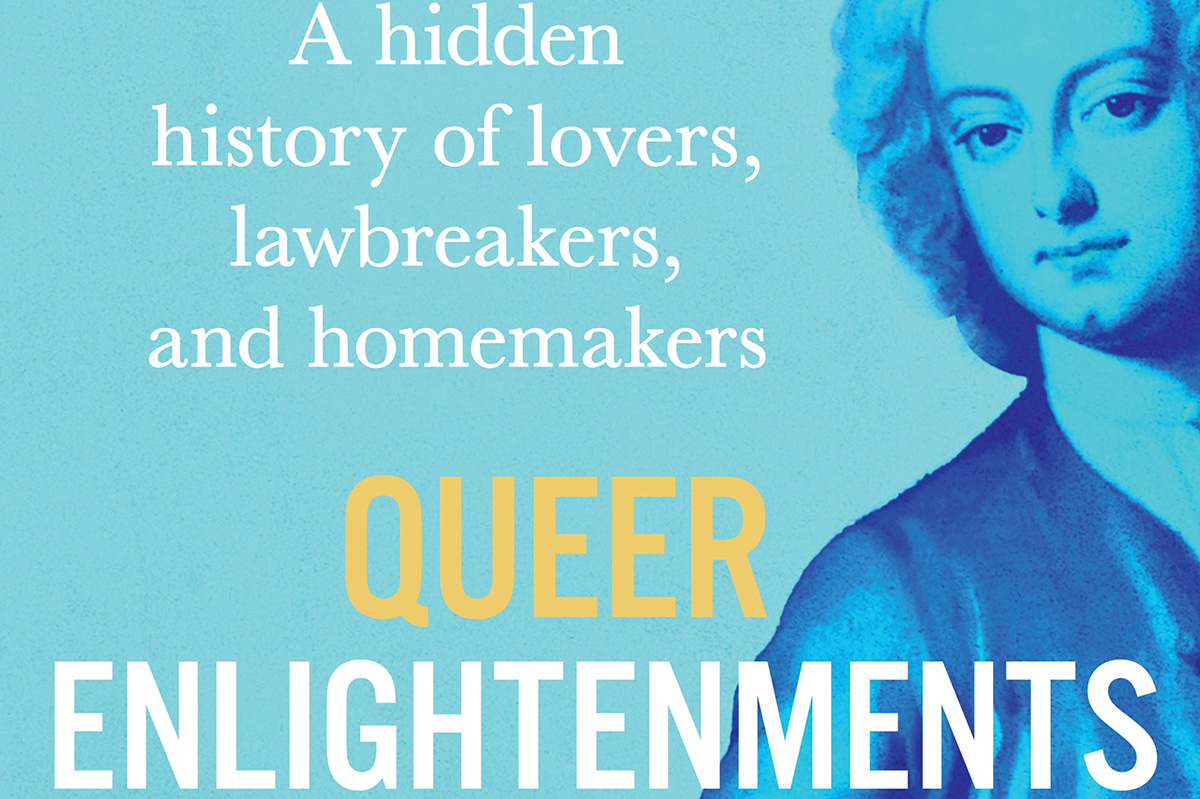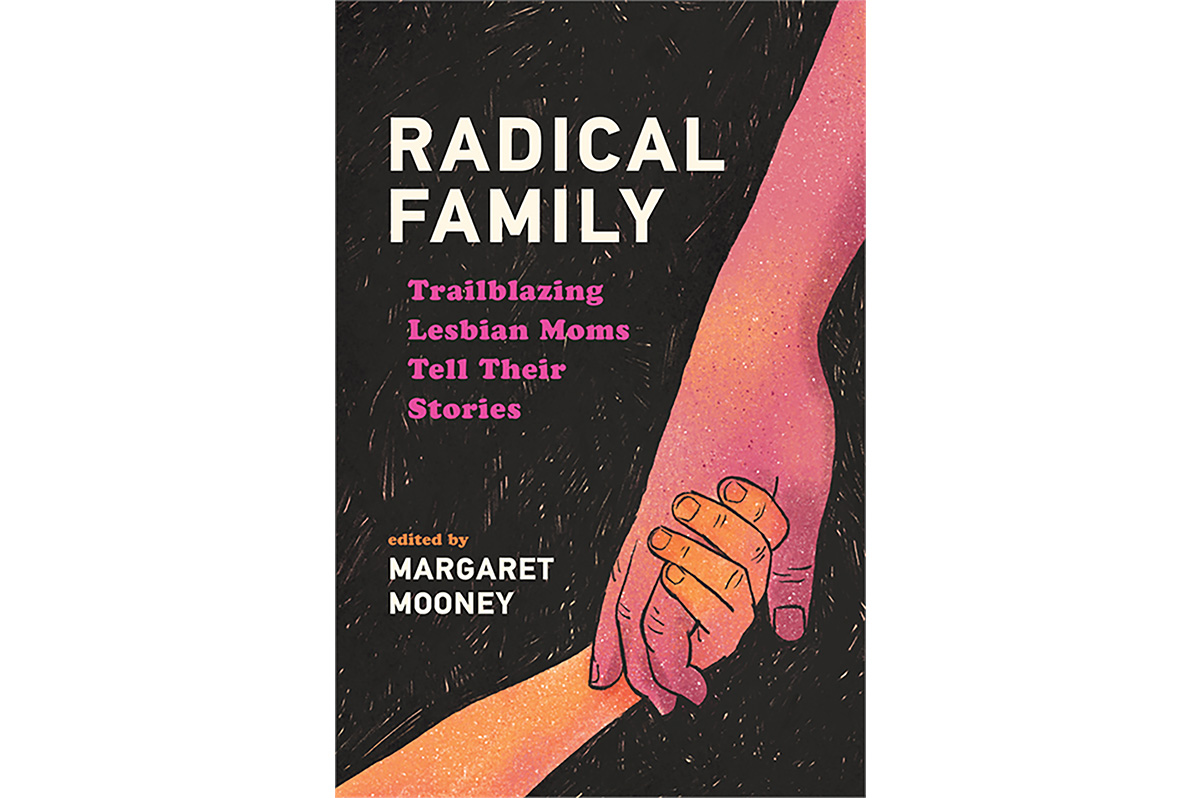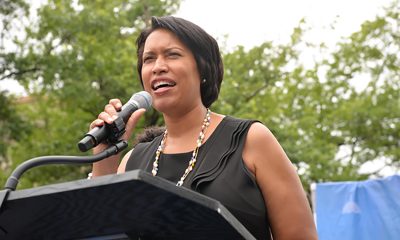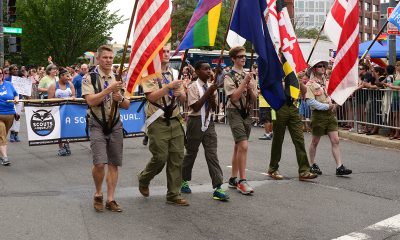Books
Tori Amos memoir ‘Resistance’ both profound and opaque
Singer/songwriter writes movingly of LGBT issues, family death while keeping the curtain closed on some aspects of her life and passions


‘Resistance: a Songwriter’s Story of Hope, Change and Courage’
By Tori Amos
Atria Books
Released May 5
272 pages
$26
A somewhat common — but far from universal — observation in Tori Amos fan circles is that her newer albums just aren’t as good as her definitive ‘90s masterpieces.
This isn’t unique to Amos. Some artists only have one or two good albums in them total (Alanis Morissette, Jewel) but keep issuing new albums that feel creatively spent. Some, like Lauryn Hill, don’t even bother to try. How many artists can keep a decade-long, white hot streak going indefinitely? And continue blowing the minds of fans who just get more jaded and less easy to impress as they, like the artist, age?
But even Amos herself has seemed curiously uninvested in later albums like “Native Invader” (2017) and “Unrepentant Geraladines” (2014). Her last tour was dubbed the “Native Invader Tour,” yet at her last area appearance in 2017, she played only two songs from the “Native Invader” album (and one was a bonus track at that!). That was typical of her shows that year. This is drastically reduced from her earlier practices. There are always a few standout tracks on each, but the overall impact has felt curiously clinical, musically bloodless. (If you want a super deep dive on this topic, Matthew Barton wrote a brilliant essay this week for The Quietus.)
What has become almost more interesting, though, is what she’s had to say, not sing. She’s always game to do a bounty of press — print and video/TV — with each new cycle (radio, of course, hasn’t played her for ages and never did much anyway) and the Amos we’ve gotten to know in these exchanges (a 2017 Vulture chat is especially good) is wise, illuminating, kooky and engaging.
Thankfully, a lot of that translates into her new memoir “Resistance: a Songwriter’s Story of Hope, Change and Courage,” out this month from Atria Books. It follows her 2005 memoir “Piece by Piece.” Its main thesis — that artists have a social responsibility to combat mercenary forces both political and systemic — is reasonably supported but far from what’s most interesting about it.
Although Amos has always had queer sensibility (she’s straight), what’s pleasantly surprising about the book is how much queer content it contains. In Amos’ mind, sexism — she argues convincingly it’s rampant in the music industry — and homophobia are twin sins and that’s linked her cozily with gay men since her early days playing at Mr. Henry’s a gay bar in Georgetown where Amos got her start at age 13, an experience the daughter of a United Methodist pastor describes in religious terms.
“Perhaps because it was gay men who took me under their wing when I was 13 and taught me how to survive — even at times through a large dose of reality, spelling out how a teenage girl in Washington could be manipulated — well, that’s its own song and those rivers run deep. Those fairy godfathers trying to teach me a drop of grace can go a long way, a lesson that my inner lioness needs reminding of a lot, but they gave and gave and gave and did not give up on me. Praise Jesus. So they led me, baptized in the barroom, to strength, to visibly blossom.”
She also writes of a 2014 concert she gave in Moscow on a stage at Crocus Arena where Putin was to appear the following day. Outraged by a 2013 “gay propaganda” law Putin had signed that made it illegal to tell LGBT Russian youth they were normal and give them reliable information on sexual orientation and gender identity, Amos tailored her set list to reflect her inner protest.
“The persecution of the LGBTQ community was — and is — real and terrifying,” she writes. “My set list in Moscow would speak loud and clear.”
Amos also writes briefly of a similar experience at at 2014 concert she gave in Istanbul.
Throughout the book, Amos-penned songs are shared that dovetail the various topics she covers. “Ophelia” closes a section about the confirmation of Supreme Court Justice Brett Kavanaugh in 2018 and “Cornflake Girl” is placed with a painful essay on female genital mutilation (it’s way more common in parts of the world than you’d guess).
Things lag a bit in a lengthy passage about the 1979-1981 Iran hostage crisis in which 52 Americans were held hostage for 444 days during a diplomatic standoff. Amos, still a D.C. piano bar regular at the time, writes of the change in the air when Reagan took office. Then Speaker of the House Tip O’Neill even joined her once at the piano to sing “Bye Bye Blackbird,” which she writes of fondly. Although always interesting to hear about, it at times feels like Amos is trying to play up her inside-the-Beltway locale to be of more import than it likely was. She writes of observing Hill movers and shakers conducting business over cocktails but how much could she really have overheard belting away at the ivories?
For me, the most gripping passages were the ones from Amos’ own life such as the initial rejection of her debut solo album “Little Earthquakes” by Atlantic Records in 1991, her experience being in New York City on 9-11 and her mom’s 2019 death following a debilitating stroke.
Other standout passages include fresh perspectives on Amos’ fraught relationship with Baltimore’s Peabody Conservatory (she was kicked out as a teen but invited back in 2019 to give a commencement address) and descriptions of her artistic process where she’s at times ethereal (she speaks often of the muses that bring her inspiration) and practical describing the often painstaking process of culling her musical noodlings and fragments into usable sonic wheat.
Her observations are at times profound. She writes of what she believes is the fallowness of the notion of artistic barrenness: “People who are addicted to power … can weaponize the thought of being creatively barren in order to debilitate the artist. They target artists specifically because they know that artists have the ability to reach the public in ways no one else can.” Ever worked with a narcissist? Those words ring true.
There are handfuls of “Gold Dust” (to use one of Amos’s songs) scattered piquantly throughout “Resistance.”
Despite the sometimes heavy topics, the essays are fairly short and tight. It feels like a nice, long visit with a trusted ally but she’s sharing not just off the top of her head, but on topics she’s in many cases spent a lifetime pondering — grief, honoring one’s instrument and inspiration, the price of selling out, how to stay in the game when the straight, white old boys’ club hold all the good cards and so on.
My quibbles are that I was hoping her husband and musical partner Mark Hawley — an artistic enigma who seems to not just enjoy but practically demand staying in the background — had emerged as a more fully formed figure. So little is known about him, yet so heavy has his influence been on Amos’s career, that he looms like a specter over the Amos universe.
It’s also highly odd that Amos mentions the death of her sole brother only in passing (were they simply not close? If so, why?) and that former boyfriend Eric Rosse is mentioned just once. He was the co-producer of her career-defining first two solo albums; their breakup, which Amos has never said much about, in part inspired her masterwork “Boys for Pele” (1996). They’ve been apart long enough now, surely she can assess his contributions to her formative works more unemotionally now, one presumes. So why does she barely acknowledge him?
And while Amos does write movingly of how mortifying the Y Kant Tori Read (her first band, which bombed with one 1988 album) era was, she’s frustratingly scant on details — did she feel musical kinship with her bandmates? How did they form? When did they officially disband? Did they provide any solace in the failure or accept any of the responsibility? Where are they now? And perhaps, more metaphysically, could there have ever been a “Little Earthquakes” if Y Kant Tori Read hadn’t happened? Amos blames herself for sinning against her art and her instrument and selling out but without sin there’s no redemption, artistic or otherwise.
That, perhaps, is what’s missing from Amos’ later work. Even with the usual struggles life eventually brings us all — the death of a parent most pronouncedly — Amos is almost too wise, too mature, too stable, too grounded to conjure up the woozy heat of earlier songs like “Bliss,” “Spark” or “Blood Roses.” It’s unfair, one must acknowledge, to expect her to maintain the kind of white-hot streak she had going ’til about “To Venus and Back” (1999). What would a 2020 Kurt Cobain album sound like had he lived?
Still it’s a bittersweet aftertaste “Resistance” leaves — as warmly as it goes down — that these are considerations a long-time fan can’t help but ponder.
Books
Pioneering gay journalist takes on Trump 2.0 in new book
Nick Benton’s essays appeared in Fall Church News-Press

Nicholas Benton is a well-known local LGBTQ advocate and journalist and the longtime owner and editor of the Falls Church News-Press, a weekly newspaper.
In his eighth book out now, Benton offers a new set of remarkable essays all crafted in the first eight months of Trump 2.0 and its wholesale effort at dismantling democracy and the rule of law. Most were published in the Falls Church News-Press, but he adds a new piece to this volume, as an addendum to his “Cult Century” series, revealing for the first time his experiences from decades ago in the political cult of Lyndon LaRouche, aimed at providing a clearer grasp of today’s Cult of Trump.
His “Please Don’t Eat Your Children” set takes off from the satire of Jonathan Swift to explore society’s critical role of drumming creativity out of the young.

Below is an excerpt from “Please Don’t Eat Your Children, Cult Century, and other 2025 Essays.”
Please Don’t Eat Your Children
In his famous short essay, “A Modest Proposal: For Preventing the Children of Poor People in Ireland From Being a Burden to Their Parents or Country and for Making Them Beneficial to the Public,” author and Anglican priest Jonathan Swift (1667-1745) uses cutting satire to suggest that cannibalism of the young might help solve a battery of social ills.
As we examine our broken society today, it seems to me that reflecting on Swift’s social critique can be quite useful. Now we face a nation filled with anger and division and there is little to suggest any real solutions other than insisting people “don’t do that!” We can start out with the observation that young children, left to their own, are neither hateful nor cruel. How do they get that way later on in their lives? What drives them toward such emotional states and behaviors? It is not a problem only for the margins of society, for the extreme misfits or troubled. It is defining the very center of our culture today. Our divisions are not the cause, but the result of something, and nobody is saying what that is.
Swift doesn’t say what it is in his biting little essay. But it is implied by a context of a lack of bounty, or poverty, on the one hand, and an approach to it characterized by obscenely cruel indifference, on the other. He coined the phrase “useless eaters” in defining his radical solution. In Hitler’s Germany, that term resonated through the death camps and some in our present situation are daring to evoke it again as the current administration pushes radical cuts in Medicaid funding.
But while that refers to the old and infirm, mostly, it is the young we are talking about here. The problem is that our society is structured to devour our young and as they begin to find that out, they rebel. Not in all cases is this the practice, of course. Where there is little or no lack, things are different. We nurture our young, as we should, and we love them. Lucky is the child who is born to parents who are of means, and in a community where nurture is possible and valued. But even such children are ultimately not immune from facing a destiny of pale conformity battered by tightly delimited social expectations and debt slavery. If they have enough ambition, education and doors opened for them, some can run the gauntlet with relative effectiveness. Otherwise, our young are raised to die on battlefields, or to struggle in myriad other painful social conflicts aimed at advancing the world of their elders. In the Bible, there is a great admonition against this process that comes at the very precondition for the tradition it represents that begins with Abraham.
It is in the book of Genesis at the beginning of the Biblical story when, as that story goes, God commanded Abraham to kill his son, Isaac, as a sacrifice. As Abraham is about to obey, God steps in and says no. The entire subsequent eons-long struggle to realize Abraham’s commission by God to make a great nation that would be a light to the world would have been cut short right then if Abraham had slain his own son. The message is that all of the Abrahamic traditions, Judaism, Islam and Christianity, owe their source, and in fact are rooted, in God’s command to reject the sacrifice of children to the whims of their elders. The last thousands of years can be best defined in these terms, where nurture is pitted against exploitation of our young with, at best, vastly mixed results. Scenes like that at the opening of “All Quiet on the Western Front,” the World War I novel and film where a teacher rallies a classroom full of boys to enlist in the war, is bone chilling. Or, the lyric in Pink Floyd’s iconic song, Comfortably Numb, “When I was a child, I caught a fleeting glimpse out of the corner of my eye. I turned to look but it was gone. I cannot put my finger on it now. The child is grown, the dream is gone.”
Nick Benton’s new book is available now at Amazon.
The Blade may receive commissions from qualifying purchases made via this post.
Books
New book highlights long history of LGBTQ oppression
‘Queer Enlightenments’ a reminder that inequality is nothing new

‘Queer Enlightenments: A Hidden History of Lovers, Lawbreakers, and Homemakers’
By Anthony Delaney
c.2025, Atlantic Monthly Press
$30/352 pages
It had to start somewhere.
The discrimination, the persecution, the inequality, it had a launching point. Can you put your finger on that date? Was it DADT, the 1950s scare, the Kinsey report? Certainly not Stonewall, or the Marriage Act, so where did it come from? In “Queer Enlightenments: A Hidden History of Lovers, Lawbreakers, and Homemakers” by Anthony Delaney, the story of queer oppression goes back so much farther.

The first recorded instance of the word “homosexual” arrived loudly in the spring of 1868: Hungarian journalist Károly Mária Kerthbeny wrote a letter to German activist Karl Heinrich Ulrichs referring to “same-sex-attracted men” with that new term. Many people believe that this was the “invention” of homosexuality, but Delaney begs to differ.
“Queer histories run much deeper than this…” he says.
Take, for instance, the delightfully named Mrs. Clap, who ran a “House” in London in which men often met other men for “marriage.” On a February night in 1726, Mrs. Clap’s House was raided and 40 men were taken to jail, where they were put in filthy, dank confines until the courts could get to them. One of the men was ultimately hanged for the crime of sodomy. Mrs. Clap was pilloried, and then disappeared from history.
William Pulteney had a duel with John, Lord Hervey, over insults flung at the latter man. The truth: Hervey was, in fact, openly a “sodomite.” He and his companion, Ste Fox had even set up a home together.
Adopting your lover was common in 18th century London, in order to make him a legal heir. In about 1769, rumors spread that the lovely female spy, the Chevalier d’Éon, was actually Charles d’Éon de Beaumont, a man who had been dressing in feminine attire for much longer than his espionage career. Anne Lister’s masculine demeanor often left her an “outcast.” And as George Wilson brought his bride to North American in 1821, he confessed to loving men, thus becoming North America’s first official “female husband.”
Sometimes, history can be quite dry. So can author Anthony Delaney’s wit. Together, though, they work well inside “Queer Enlightenments.”
Undoubtedly, you well know that inequality and persecution aren’t new things – which Delaney underscores here – and queer ancestors faced them head-on, just as people do today. The twist, in this often-chilling narrative, is that punishments levied on 18th- and 19th-century queer folk was harsher and Delaney doesn’t soften those accounts for readers. Read this book, and you’re platform-side at a hanging, in jail with an ally, at a duel with a complicated basis, embedded in a King’s court, and on a ship with a man whose new wife generously ignored his secret. Most of these tales are set in Great Britain and Europe, but North America features some, and Delaney wraps up thing nicely for today’s relevance.
While there’s some amusing side-eyeing in this book, “Queer Enlightenments” is a bit on the heavy side, so give yourself time with it. Pick it up, though, and you’ll love it til the end.
The Blade may receive commissions from qualifying purchases made via this post.
Books
A history of lesbian workarounds to build family
Fighting for the right to have and raise kids

‘Radical Family: Trailblazing Lesbian Moms Tell Their Stories’
Edited by Margaret Mooney
c.2025, Wisconsin Historical Society Press
$20/150 pages
You don’t have a white picket fence with an adorable gate.
The other parts of the American Dream – the house in the suburbs, a minivan, and a big backyard – may also be beyond your reach. You’ve never wanted the joyous husband-wife union, but the two-point-five kids? Yeah, maybe that’s possible. As in the new book “Radical Family,” edited by Margaret Mooney, it’s surely more so than it was in the past.

Once upon a time, if a lesbian wanted to raise a family, she had two basic options: pregnancy or adoption. That is, says Mooney, if she was willing to buck a hetero-centric society that said the former was “selfish, unnatural and radical” and the latter was often just simply not possible or even legal.
Undaunted, and very much wanting kids, many lesbians ignored the rules. They built “chains” of women who handed off sperm from donor to doctor to potential mother. They demanded that fertility clinics allow single women as customers. They wrote pamphlets and publications aimed to help others become pregnant by themselves or with partners. They carefully sought lesbian-friendly obstetricians and nurses.
Over time, lesbians who wanted kids were “emboldened by the feminist movement and the gay and lesbian rights movement” and did what they had to do, omitted facts when needed, traveled abroad when they could, and found workarounds to build a family.
This book tells nine stories of everyday lesbians who succeeded.
Denise Matyka and Margaret McMurray went to Russia to adopt. Martha Dixon Popp and Alix Olson raised their family, in part and for awhile in conjunction with Popp’s husband. Gail Hirn learned from an agriculture publication how to inseminate herself. MC Reisdorf literally stood on her head to get pregnant. Mooney says that, like most lesbian parents then, she became a mother “without any safety nets…”
Such “struggles likely will feel familiar as you read about [the] desire to become parents…” says Mooney. “In short, these families are ordinary and extraordinary all at once.”
In her introduction, editor Margaret Mooney points out that the stories in this book generally take place in the latter part of the last century, but that their relevance is in the struggles that could happen tomorrow. There’s urgency in those words, absolutely, and they’re tinged with fear, but don’t let them keep you from “Radical Family.”
What you’ll see inside these nine tales is mostly happy, mostly triumphant – and mostly Wisconsin-centric, though the variety in dream-fulfillment is wide enough that the book is appropriate anywhere. The determination leaps out of the pages here, and the storytellers don’t hide their struggles, not with former partners, bureaucracy, or with roadblocks. Reading this book is like attending a conference and hearing attendees tell their tales. Bonus: photos and advice for any lesbian thinking of parenthood, single or partnered.
If you’re in search of positive stories from lesbian mothers and the wall-busting they did, or if you’ve lived the same tales, this slim book is a joy to read. For you, “Radical Family” may open some gates.
The Blade may receive commissions from qualifying purchases made via this post.
-

 District of Columbia2 days ago
District of Columbia2 days agoBowser announces she will not seek fourth term as mayor
-

 U.S. Military/Pentagon2 days ago
U.S. Military/Pentagon2 days agoPentagon moves to break with Boy Scouts over LGBTQ and gender inclusion
-

 Drag3 days ago
Drag3 days agoPattie Gonia calls out Hegseth’s anti-LGBTQ policies — while doing better pull-ups
-

 District of Columbia3 days ago
District of Columbia3 days agoSecond gay candidate announces run for Ward 1 D.C. Council seat



















